Effect of Scanning Routes on the Stress and Deformation of Overhang Structures Fabricated by SLM
Abstract
:1. Introduction
2. Materials and Methods
3. Results
4. Analysis and Discussion
4.1. Numerical Simulation
4.2. Discussion
5. Conclusions
- The longitudinal scanning resulted in a significant upward bending deformation of the overhang as it was cut from the baseplate. However, there was less deformation of the overhang as it was fabricated by the transverse and alternating scanning routes.
- The longitudinal scanning made the temperature distribution of the entire overhang relatively uniform, which made the overhang contract simultaneously. However, the transverse scanning made the high temperature zone exist at the final scanning area, which made the overhang contract in the longitudinal direction at different time periods.
- The longitudinal scanning resulted in significant residual stress on the overhang. However, the transverse scanning route significantly decreased the residual stress.
- The transverse scanning route can avoid the simultaneous contraction along the entire overhang. The discontinuous transverse scanning route further reduced the residual stress and deformation of the overhang.
Author Contributions
Funding
Conflicts of Interest
References
- Birtchnell, T.; Urry, J. 3D, SF and the future. Futures 2013, 50, 25–34. [Google Scholar] [CrossRef]
- Sames, W.J.; List, F.A.; Pannala, S.; Dehoff, R.R.; Babu, S.S. The metallurgy and processing science of metal additive manufacturing. Int. Mater. Rev. 2016, 61, 315–360. [Google Scholar] [CrossRef]
- Kruth, J.P.; Badrossannay, M.; Yasa, E.; Deckers, J.; Thijs, L.; Van Humbeeck, J. Part and Material Properties in Selective Laser Melting of Metals. Rapid Prototyp. J. 2010, 3–14. [Google Scholar] [CrossRef]
- Thijs, L.; Verhaeghe, F.; Craeghs, T.; Van Humbeeck, J.; Kruth, J.-P. A study of the micro structural evolution during selective laser melting of Ti-6Al-4V. Acta Mater. 2010, 58, 3303–3312. [Google Scholar] [CrossRef]
- Thijs, L.; Kempen, K.; Kruth, J.-P.; Van Humbeeck, J. Fine-structured aluminium products with controllable texture by selective laser melting of pre-alloyed AlSi10Mg powder. Acta Mater. 2013, 61, 1809–1819. [Google Scholar] [CrossRef] [Green Version]
- Gu, D.D.; Meiners, W.; Wissenbach, K.; Poprawe, R. Laser additive manufacturing of metallic components: Materials, processes and mechanisms. Int. Mater. Rev. 2012, 57, 133–164. [Google Scholar] [CrossRef]
- Brandl, E.; Heckenberger, U.; Holzinger, V.; Buchbinder, D. Additive manufactured AlSi10Mg samples using Selective Laser Melting (SLM): Microstructure, high cycle fatigue, and fracture behavior. Mater. Des. 2012, 34, 159–169. [Google Scholar] [CrossRef]
- Olakanmi, E.O.; Cochrane, R.F.; Dalgarno, K.W. A review on selective laser sintering/melting (SLS/SLM) of aluminium alloy powders: Processing, microstructure, and properties. Prog. Mater. Sci. 2015, 74, 401–477. [Google Scholar] [CrossRef] [Green Version]
- Kruth, J.P.; Levy, G.; Klocke, F.; Childs, T.H.C. Consolidation phenomena in laser and powder-bed based layered manufacturing. Cirp Ann. Manuf. Technol. 2007, 56, 730–759. [Google Scholar] [CrossRef]
- AlMangour, B.; Grzesiak, D.; Yang, J.-M. Scanning strategies for texture and anisotropy tailoring during selective laser melting of TiC/316L stainless steel nanocomposites. J. Alloy. Compd. 2017, 728, 424–435. [Google Scholar] [CrossRef]
- Deng, C.; Kang, J.; Feng, T.; Feng, Y.; Wang, X.; Wu, P. Study on the Selective Laser Melting of CuSn10 Powder. Materials 2018, 11, 614. [Google Scholar] [CrossRef] [PubMed]
- Buchbinder, D.; Meiners, W.; Pirch, N.; Wissenbach, K.; Schrage, J. Investigation on reducing distortion by preheating during manufacture of aluminum components using selective laser melting. J. Laser Appl. 2014, 26. [Google Scholar] [CrossRef]
- Mugwagwa, L.; Dimitrov, D.; Matope, S.; Yadroitsev, I. Influence of process parameters on residual stress related distortions in selective laser melting. Procedia Manuf. 2018, 21, 92–99. [Google Scholar] [CrossRef]
- Mercelis, P.; Kruth, J.-P. Residual stresses in selective laser sintering and selective laser melting. Rapid Prototyp. J. 2006, 12, 254–265. [Google Scholar] [CrossRef]
- Zaeh, M.F.; Branner, G. Investigations on residual stresses and deformations in selective laser melting. Prod. Eng. 2010, 4, 35–45. [Google Scholar] [CrossRef]
- Kruth, J.-P.; Deckers, J.; Yasa, E.; Wauthle, R. Assessing and comparing influencing factors of residual stresses in selective laser melting using a novel analysis method. Proc. Inst. Mech. Eng. Part B J. Eng. Manuf. 2012, 226, 980–991. [Google Scholar] [CrossRef]
- Parry, L.; Ashcroft, I.A.; Wildman, R.D. Understanding the effect of laser scan strategy on residual stress in selective laser melting through thermo-mechanical simulation. Addit. Manuf. 2016, 12, 1–15. [Google Scholar] [CrossRef] [Green Version]
- Cheng, B.; Shrestha, S.; Chou, K. Stress and deformation evaluations of scanning strategy effect in selective laser melting. Addit. Manuf. 2016, 12, 240–251. [Google Scholar] [CrossRef]
- Papadakis, L.; Loizou, A.; Risse, J.; Schrage, J. Numerical Computation of Component Shape Distortion Manufactured by Selective Laser Melting. Procedia CIRP 2014, 18, 90–95. [Google Scholar] [CrossRef]
- Neugebauer, F.; Keller, N.; Ploshikhin, V.; Feuerhahn, F.; Köhler, H. Multi scale FEM simulation for distortion calculation in additive manufacturing of hardening stainless steel. In Proceedings of the International Workshop on Thermal Forming an Welding Distortion, Bremen, Germany, 9–10 April 2014. [Google Scholar]
- Roberts, I.A.; Wang, C.J.; Esterlein, R.; Stanford, M.; Mynors, D.J. A three-dimensional finite element analysis of the temperature field during laser melting of metal powders in additive layer manufacturing. Int. J. Mach. Tools Manuf. 2009, 49, 916–923. [Google Scholar] [CrossRef]
- Li, Y.; Gu, D. Thermal behavior during selective laser melting of commercially pure titanium powder: Numerical simulation and experimental study. Addit. Manuf. 2014, 1, 99–109. [Google Scholar] [CrossRef]
- Denlinger, E.R.; Gouge, M.; Irwin, J.; Michaleris, P. Thermomechanical model development and in situ experimental validation of the Laser Powder-Bed Fusion process. Addit. Manuf. 2017, 16, 73–80. [Google Scholar] [CrossRef]
- Alvarez, P.; Ecenarro, J.; Setien, I.; Sebastian, M.; Echeverria, A.; Eciolaza, L. Computationally efficient distortion prediction in powder bed fusion additive manufacturing. Int. J. Eng. Res. Sci. 2016, 2, 39–46. [Google Scholar]
- Touloukian, Y.S.; Powell, R.W.; Ho, C.Y.; Klemens, P.G. Thermal Conductivity: Metallic Elements and Alloys. In Thermophysical Properties of Matter; IFI/Plenum: New York, NY, USA, 1970; Volume 1. [Google Scholar]
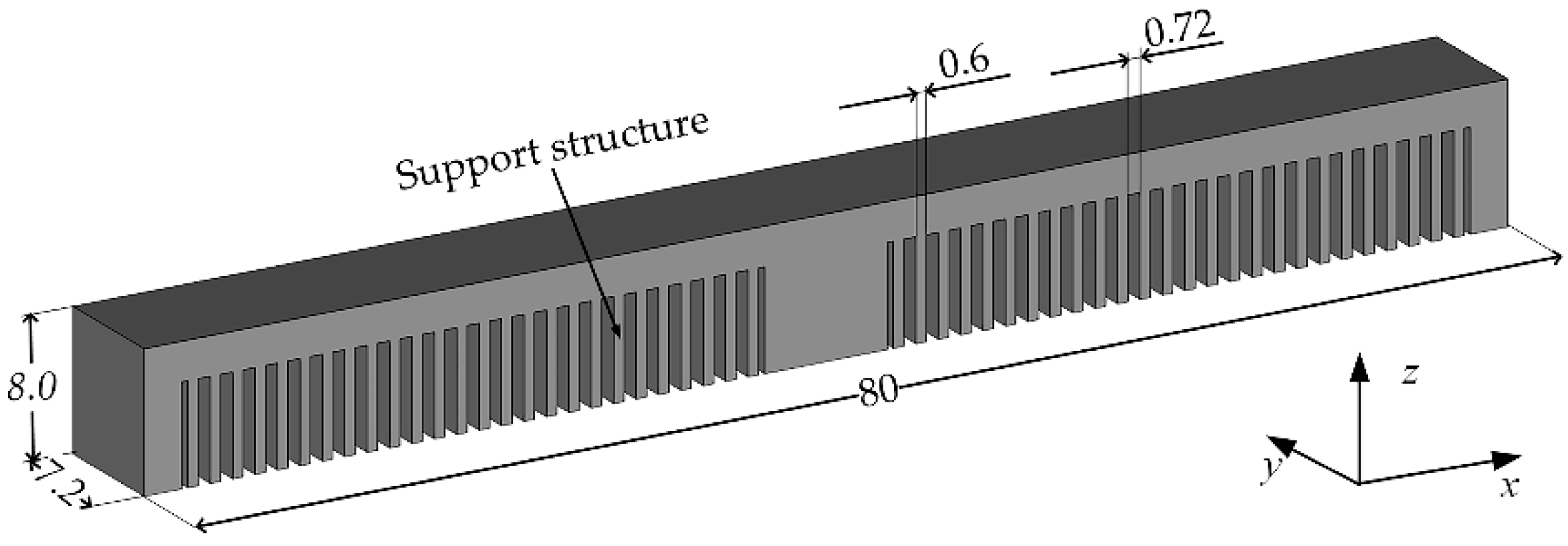

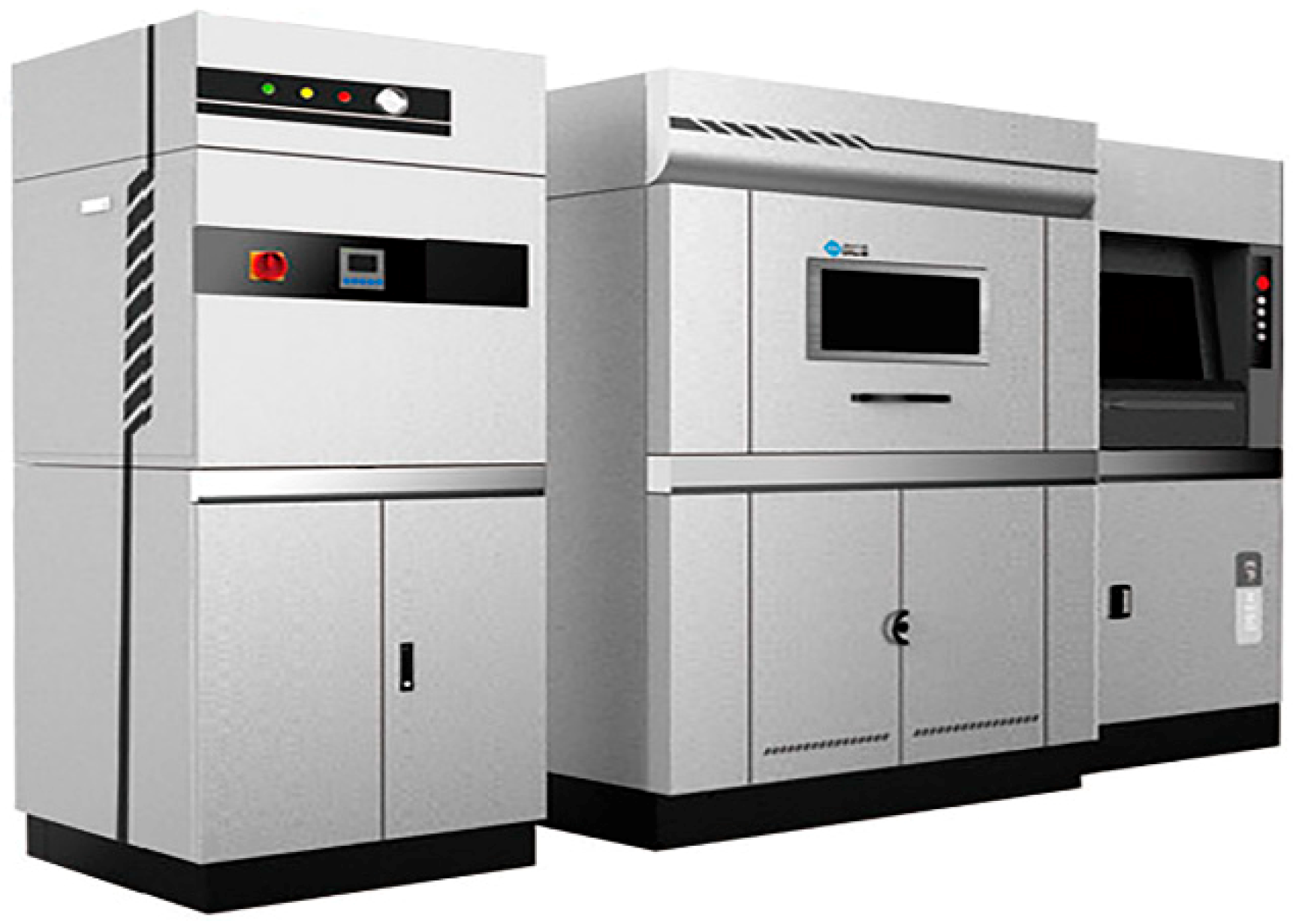

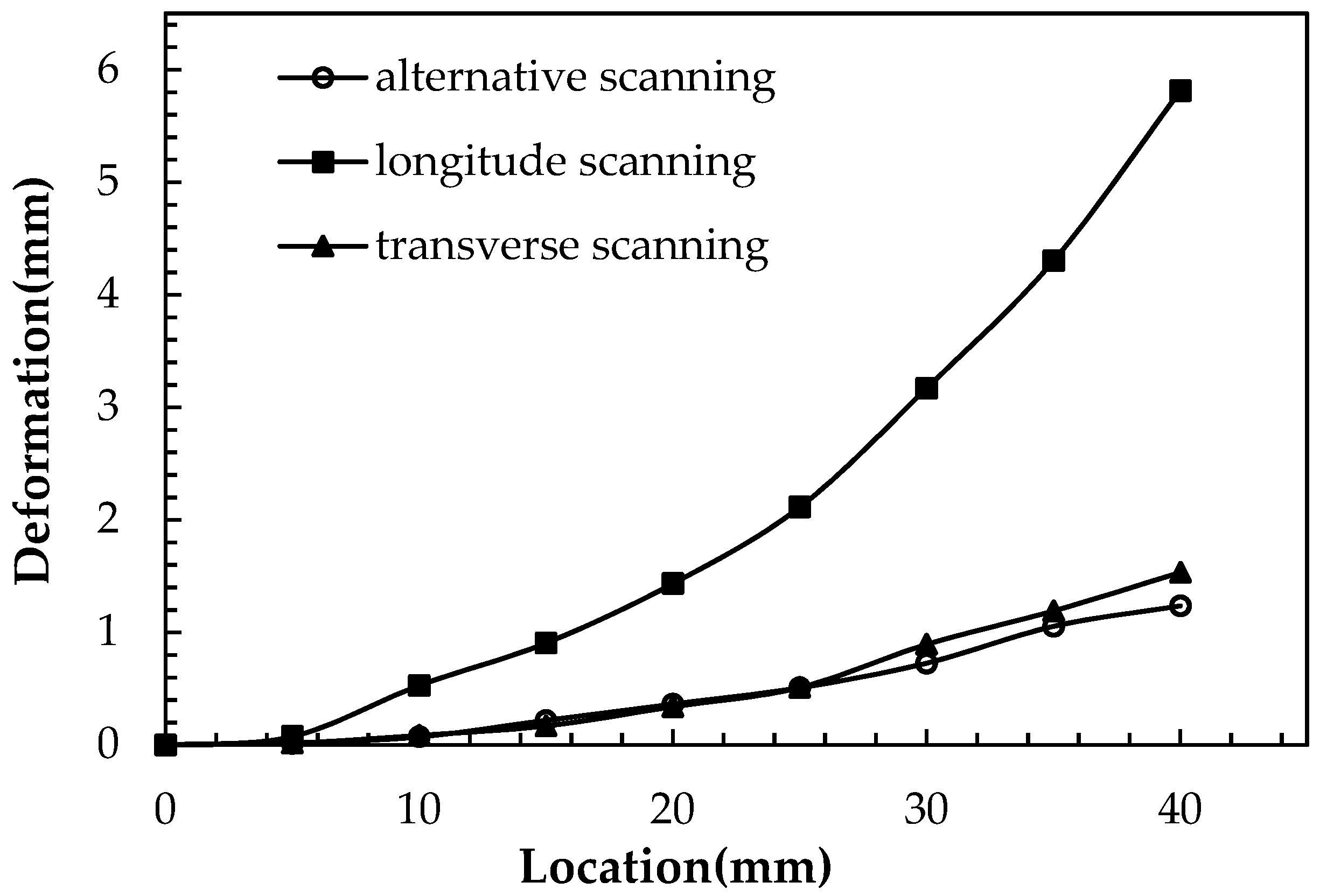
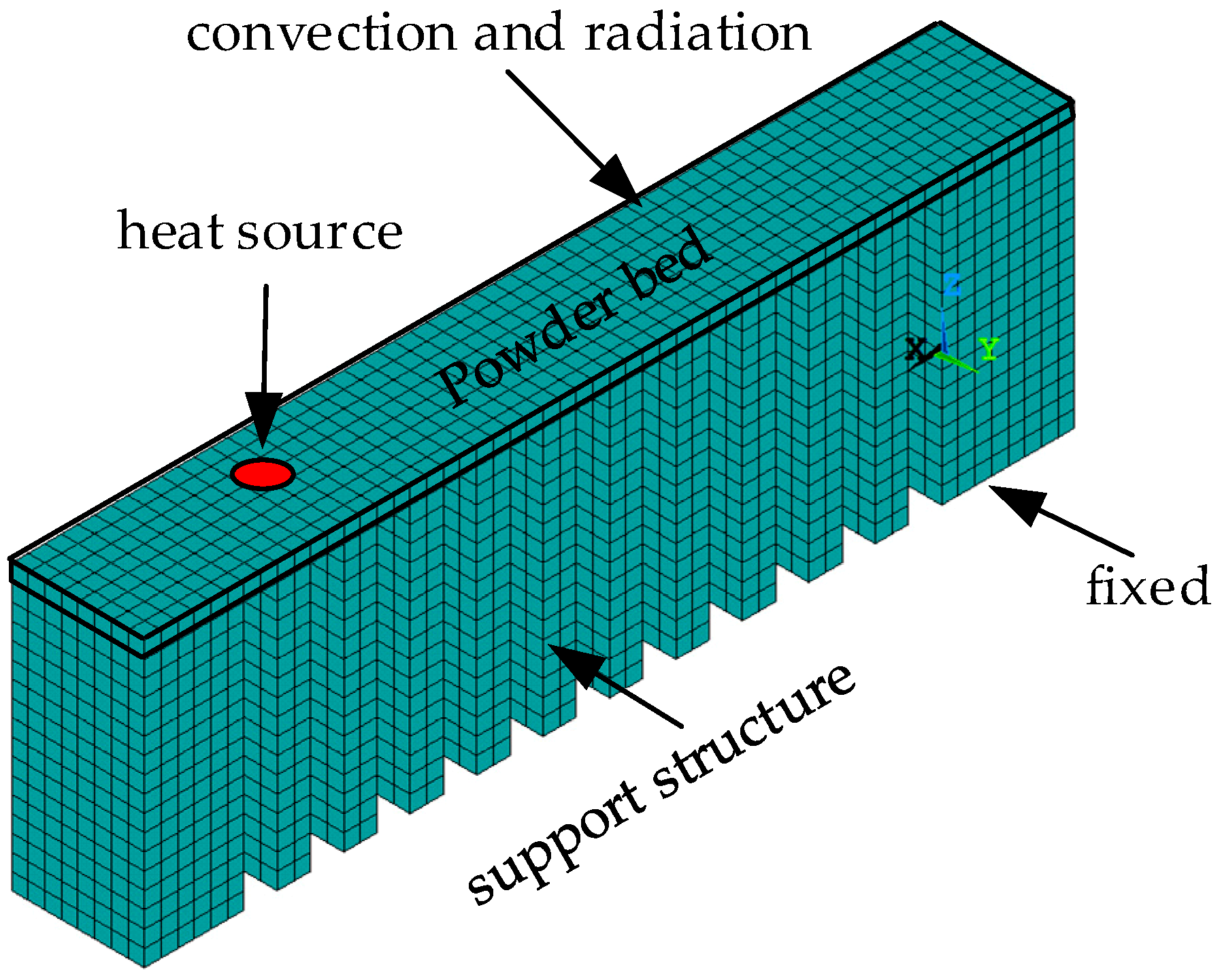
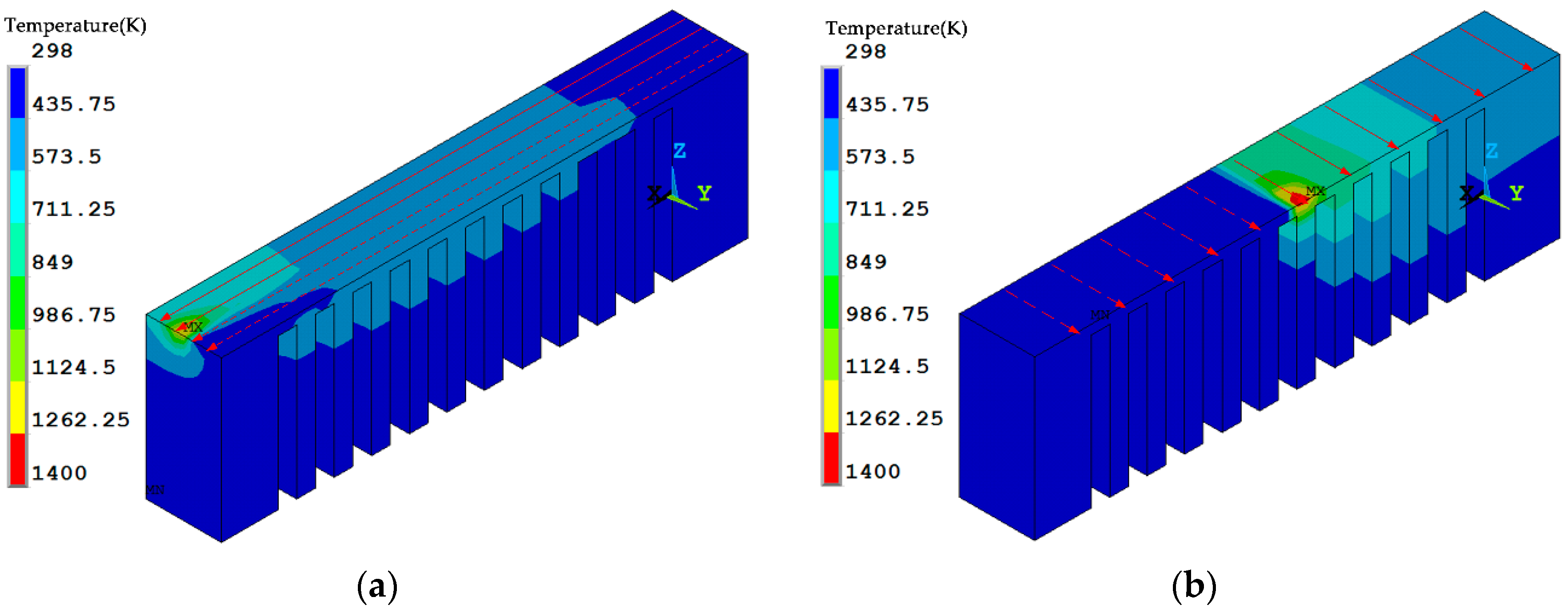
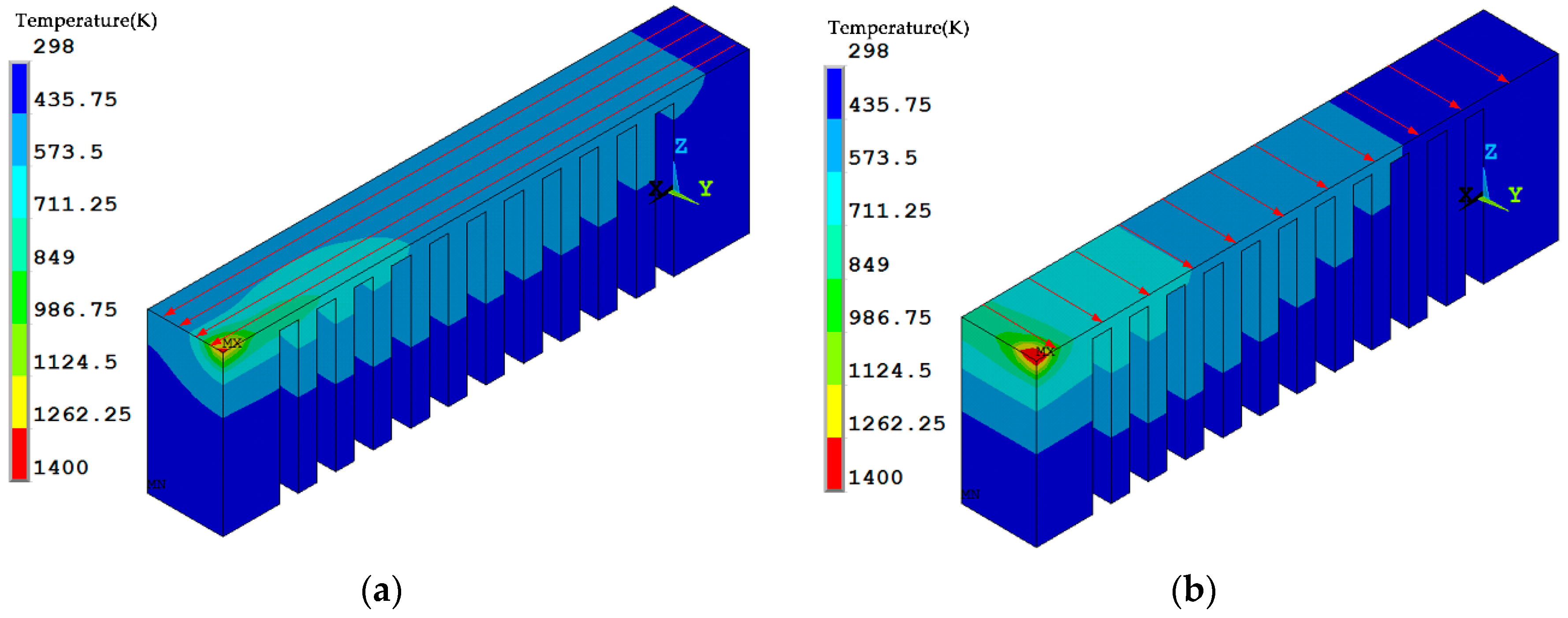
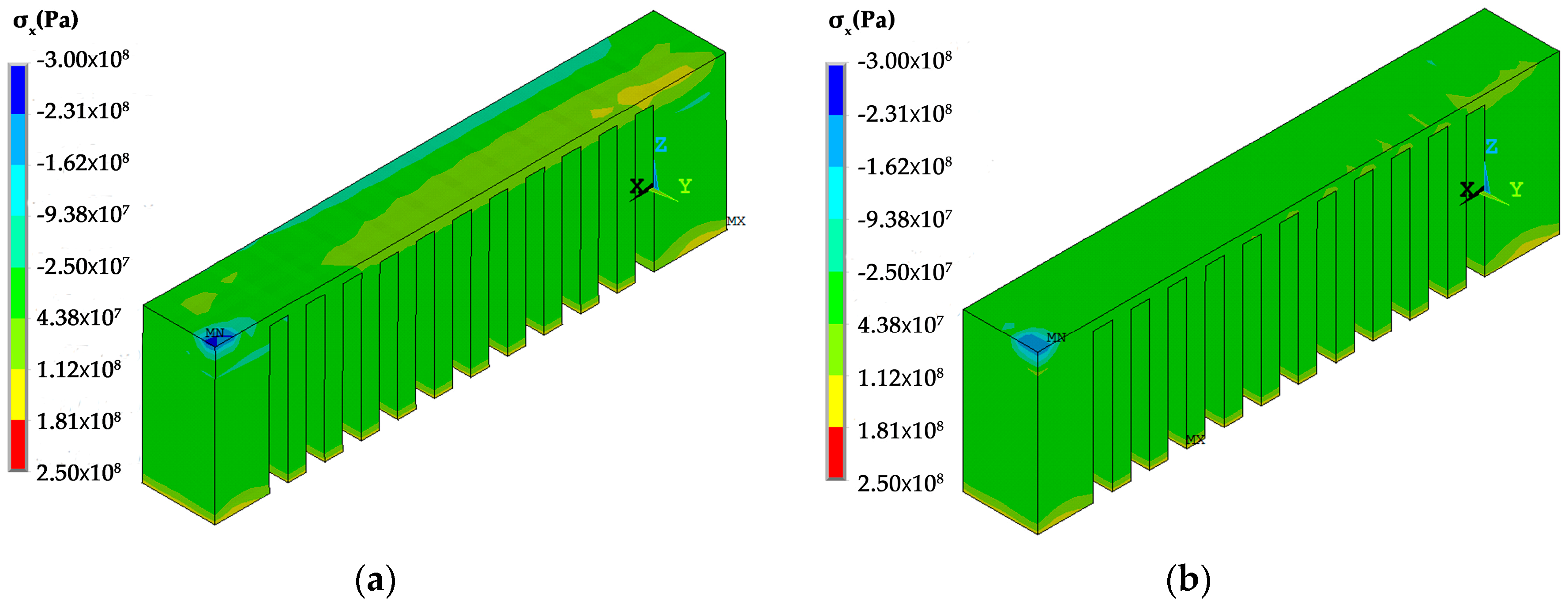
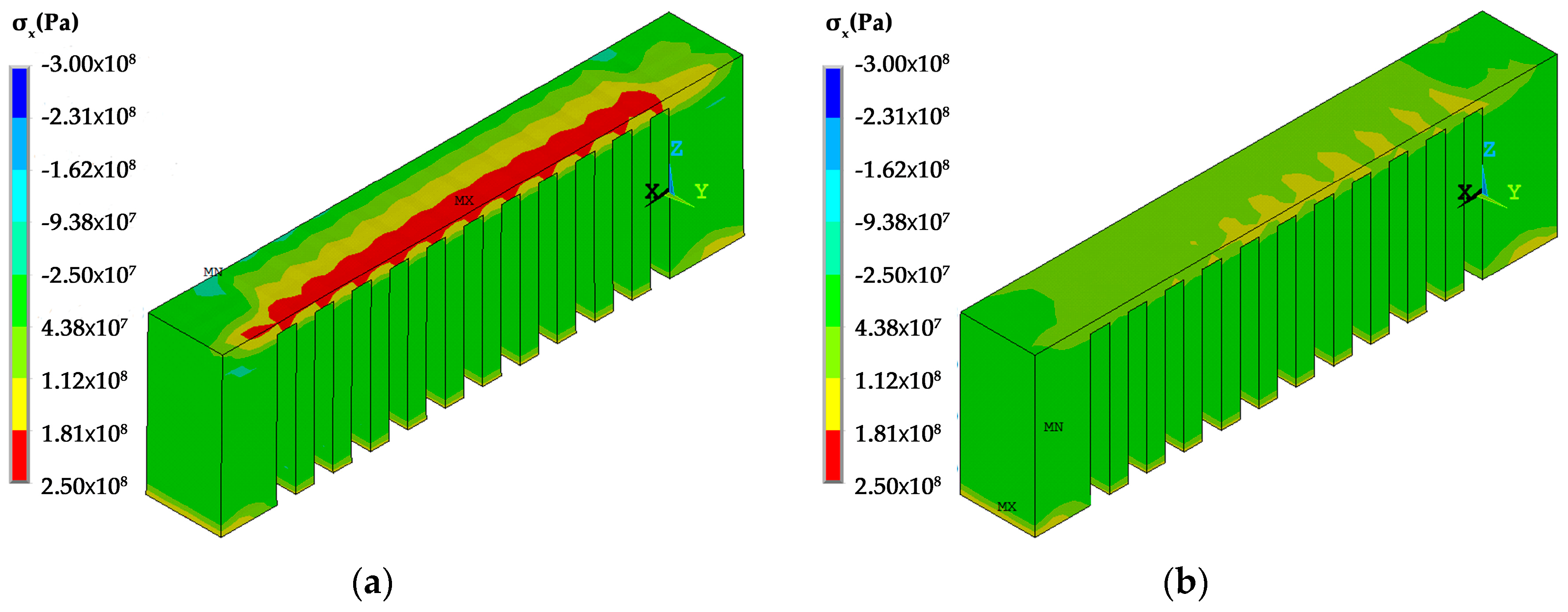





| Al | Si | Mg | Fe | Mn | Ti | Zn | Cu | Ni |
|---|---|---|---|---|---|---|---|---|
| Balance | 10.0 | 0.40 | 0.50 | 0.40 | 0.15 | 0.10 | 0.05 | 0.05 |
| Temperature (K) | 298 | 473 | 673 | 820 | 870 | 1000 |
|---|---|---|---|---|---|---|
| Density (kg/m3) | 2650 | 2550 | 2400 | 2200 | 2000 | 1900 |
| Thermal conductivity (W/(m∙K)) | 147 | 159 | 159 | 159 | 100 | 105 |
| Specific heat capacity (J/(kg∙K)) | 739 | 797 | 838 | 922 | 1100 | 1000 |
| Density (powder) (kg/m3) | 920 | 930 | 950 | 1000 | - | - |
| Thermal conductivity (powder) (W/(m∙K)) | 1.5 | 1.6 | 1.7 | 1.8 | - | - |
| Specific heat capacity (powder) (J/(kg∙K)) | 443 | 478 | 503 | 553 | - | - |
| Young’s modulus (GPa) | 69 | 67 | 62 | 53 | 41 | 30 |
| Poisson’s ratio | 0.33 | 0.33 | 0.33 | 0.33 | 0.33 | 0.4 |
| Coefficient of thermal expansion (10−6/K) | 21.7 | 22.5 | 23.5 | 23.3 | 25.5 | 25.5 |
| Yield strength (MPa) | 195 | 150 | 105 | 70 | 30 | 20 |
| Plasticity hardening coefficient (GPa) | 0.69 | 0.67 | 0.62 | 0.53 | 0.41 | 0.30 |
© 2018 by the authors. Licensee MDPI, Basel, Switzerland. This article is an open access article distributed under the terms and conditions of the Creative Commons Attribution (CC BY) license (http://creativecommons.org/licenses/by/4.0/).
Share and Cite
Zhang, X.; Kang, J.; Rong, Y.; Wu, P.; Feng, T. Effect of Scanning Routes on the Stress and Deformation of Overhang Structures Fabricated by SLM. Materials 2019, 12, 47. https://doi.org/10.3390/ma12010047
Zhang X, Kang J, Rong Y, Wu P, Feng T. Effect of Scanning Routes on the Stress and Deformation of Overhang Structures Fabricated by SLM. Materials. 2019; 12(1):47. https://doi.org/10.3390/ma12010047
Chicago/Turabian StyleZhang, Xiaochuan, Jinwu Kang, Yiming Rong, Pengyue Wu, and Tao Feng. 2019. "Effect of Scanning Routes on the Stress and Deformation of Overhang Structures Fabricated by SLM" Materials 12, no. 1: 47. https://doi.org/10.3390/ma12010047




